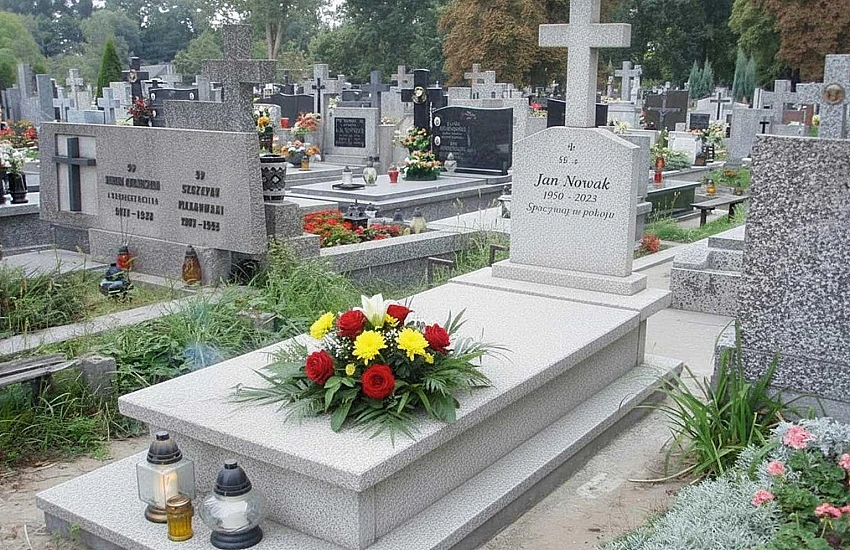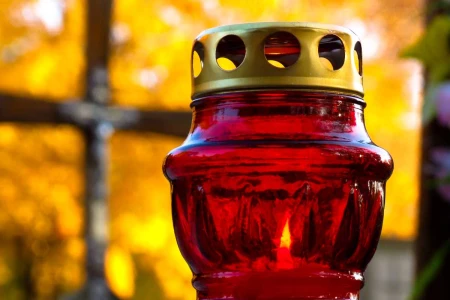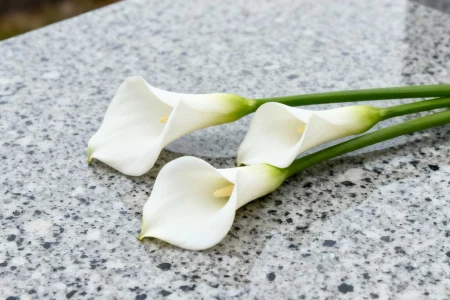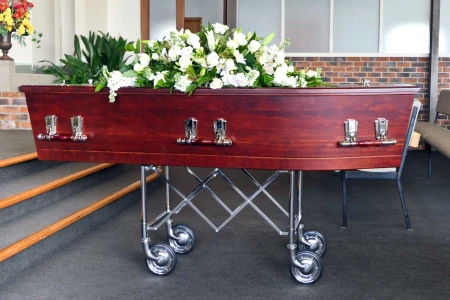Table of Contents
- The Tradition of Crosses on Christian Tombstones - Symbol of Hope and Salvation
- Jewish Symbolism on Tombstones - Star of David and Traditional Motifs
- Islamic Elements on Tombstones - Modesty and Spirituality
- Buddhist and Hindu Symbolism - Spiritual Rebirth
- Tombstones for Non-believers - Secular Symbolism
- Materials Used in Production of Religious Elements
- Maintenance and Care of Religious Elements
- Trends in Contemporary Religious Design
- Legal and Regulatory Aspects
- Costs of Religious Elements on Tombstones
- Cultural and Social Significance
- Future of Religious Elements on Tombstones
- Frequently Asked Questions (FAQ)
Tombstones are not only commemorations of the deceased but also deep expressions of faith and religious tradition. Religious elements on tombstones play a fundamental role in different cultures and denominations worldwide. From Christian cemetery crosses, through Jewish Stars of David, to Islamic crescents - each symbol carries profound spiritual and cultural meaning.
In Poland, where 87% of society is Catholic, the cemetery cross remains the most popular religious element in cemeteries. However, with the growing religious diversity of our society - officially about 30 different religious denominations are registered - we increasingly encounter other religious symbols in Polish necropolises.
The Tradition of Crosses on Christian Tombstones - Symbol of Hope and Salvation
The cemetery cross constitutes the most important element of Christian sepulchral symbolism. This universal symbol of faith, hope, and salvation has adorned the graves of believers throughout the Christian world for centuries. The Latin cross can serve as a reminder of eternal life that, according to Christian beliefs, awaits each of us on the other side.
History of Crosses on Christian Tombstones
The tradition of placing crosses on tombstones dates back to the early centuries of Christianity. Originally, Christians used discrete symbols such as fish or anchors due to religious persecution. Only after the Edict of Milan in 313 AD did the cross become a common Christian symbol, including in burial places.
In medieval Poland, cemetery crosses were often made of wood or stone. Over time, with the development of craftsmanship and availability of new materials, crosses became more sophisticated and durable. Today, cemetery crosses are made from high-quality materials ensuring longevity and aesthetics.

Types of Cemetery Crosses Available in the Offer
The modern market offers a wide range of cemetery crosses adapted to different needs and preferences. Cemetery crosses made of stainless steel are a popular choice due to their durability and resistance to atmospheric conditions.
Stainless steel crosses currently constitute the most popular choice among families. This material is characterized by exceptional corrosion resistance thanks to chromium content, which creates a protective layer on the surface. Cemetery crosses made of stainless steel are available in various shapes and sizes, and their appearance can be modified by adding different elements such as decorations, inscriptions, or additional metal elements.
Brass and bronze crosses represent an elegant alternative to stainless steel. Bronze lying crosses are not affected by frost or rain – even after years they maintain their dignified appearance. Bronze oxidized to black adds special charm and elegance to crosses, making them an exceptional element in any cemetery.
Modern cemetery crosses combine traditional symbolism with contemporary design. In modern cemetery crosses, we install stained glass or crystals (in the central point), we also use layered constructions that stand out and create aesthetic grave arrangements.
Cross Design and Symbolism of funeraryaccesories.com Offer
Each ceremonial cross available at funeraryaccesories.com is made from the highest quality materials. The production process utilizes solid wood, precious metals, and crystals, ensuring not only durability but also elegant appearance for many years of use. Cemetery crosses are made from various materials, including metal, wood, and high-quality composites, with each material carefully selected to ensure maximum durability and product aesthetics.
All cemetery crosses are designed to withstand various atmospheric conditions, including intense rainfall, snow, and harmful UV radiation. The use of special protective coatings guarantees preservation of durability and aesthetics for many years, regardless of prevailing weather conditions.
The rich assortment includes ceremonial crosses in various styles, from classical designs full of tradition to modern, minimalist projects. Such diversity allows each family to find a cross that best reflects the character of the planned ceremony and individual preferences regarding commemoration of the deceased.
The price offer of ceremonial crosses is characterized by a wide range, enabling finding an appropriate product that meets expectations without excessively burdening the family budget. The company's philosophy is based on the conviction that elegance and high quality of execution do not necessarily have to be associated with exorbitant costs.
The order fulfillment time is shaped depending on the degree of complexity of the chosen project and current material availability. For standard designs, fulfillment usually takes from one to two weeks, while orders requiring personalization may require slightly longer waiting time.
Cross Design and Symbolism
The Latin cross remains the most recognizable form of the Christian cross. Choosing a Latin cross for a tombstone is not only a matter of faith. It is also a decision that carries a certain kind of universal message about hope, love, and the ultimate victory of life over death.
The Celtic cross is gaining increasing popularity among those who value traditional symbolism. The Celtic cross, also known as the Irish cross or circle cross, is a symbol that attracts attention not only with its unique form but also with its profound meaning. With its characteristic circle around the intersection, this cross is not only a beautiful decorative element but also a strong symbol of eternity, infinity, and unity.
Crosses with passion depict the crucified Christ and are particularly popular among believers attached to traditional forms of piety. They often contain the inscription "INRI" (Iesus Nazarenus Rex Iudaeorum), emphasizing the Christological character of the symbol.
Mounting and Placement of Cemetery Crosses
Cemetery crosses can be divided into two main categories according to mounting method:
Standing crosses are mounted on special bases or directly in the ground. They are more visible and often constitute the central element of the tombstone composition. Standing crosses made of stainless steel (acid-resistant) and coated are characterized by exceptional durability and resistance to atmospheric conditions.
Lying crosses are mounted flat on the tombstone surface or burial plate. They are less exposed to mechanical damage and are often chosen for practical reasons.
Cemetery Cross Personalization
Contemporary technological possibilities allow for wide personalization of cemetery crosses. Cross personalization through engraving names, dates, or chosen quotes can make it even more personal and meaningful. Popular forms of personalization include:
- Engraving names and dates
- Adding biblical quotes or prayers
- Placing ceramic photographs
- Applying decorative elements
Where to buy a cross for the cemetery?
If you're wondering where to buy a cross for the cemetery, it's worth considering the offer of funeraryaccesories.com store. Orders can be placed directly through the website, by phone, or by visiting the physical store. The team will gladly help in selecting the appropriate product and provide all necessary information.
Professional customer service at funeraryaccesories.com:
The store team is ready to help at every stage of purchase. They will gladly advise on choosing a ceremonial cross, answer questions, and ensure that the purchase process runs smoothly and comfortably. Choosing the right ceremonial cross is an important element of every funeral ceremony. It's not just decoration, but a symbolic element that pays respect to the deceased and helps express grief and remembrance.

Jewish Symbolism on Tombstones - Star of David and Traditional Motifs
Jewish tombstones, called matzevah, are characterized by rich religious and cultural symbolism. As a result of the biblical strict prohibition on depicting human figures, Jewish art and craftsmanship developed a system of metaphorical signs.
Star of David - Central Symbol of Judaism
The Star of David is an important symbol in Judaism, so people professing this religion often choose this symbol as an expression of their deep faith. This six-pointed symbol, also called Magen David (Shield of David), performs several important functions on Jewish tombstones. First and foremost, it identifies the religious denomination of the deceased and expresses belonging to the Jewish people. At the same time, it symbolizes spiritual protection and connects with the rich tradition and cultural heritage of the Jewish community.
Among popular motifs adorning Jewish matzevah, symbols concerning the religiosity of the deceased most frequently appear. The crown has multiple meanings, symbolizing both the Torah (so it can be found on the grave of a pious sage or rabbi) and the Crown of Good Name, testifying to the exceptional nobility of the deceased. The crown also constitutes an allusion to the father of the family, being the head (crown) of the house. Grapevine and grape clusters refer to biblical metaphors of the chosen people as God's vineyard, while candlesticks symbolize the light of Torah and religious wisdom. Hands depicted in the gesture of blessing are characteristic of tombs of kohanim (priests).
Architecture of Jewish Tombstones
Over time, three types of sepulchral architecture developed: ohel, meaning "tent," a small wooden or brick building; sarcophagus; however, the most common form of Jewish tombstones is matzevah - a vertically placed stone plate.
Matzevah often contain rich symbolic decorations that for centuries constituted a way of communicating about the life and character of the deceased without violating religious prohibitions regarding the depiction of human figures.

Islamic Elements on Tombstones - Modesty and Spirituality
Islamic funeral traditions are characterized by particular modesty and spirituality. According to accepted norms, Muslim tombstones should be characterized by modesty and simplicity.
Crescent - Symbol of Islam
Placing a crescent on a tombstone remains in accordance with practices and expectations associated with Muslim burial. The crescent, often complemented by a star, constitutes a recognizable symbol of Islam on Muslim tombstones.
Islamic tombstones are characterized primarily by simplicity and modesty of execution, which reflects the basic values of this religion. They feature a lack of unnecessary ornaments and north-south orientation, i.e., toward Mecca. Often, birth dates are missing from such tombstones, but information about circumstances of death may appear. Arabic calligraphy with quotes from the Quran constitutes one of the most important decorative elements of Islamic tombstones.
Muslims visit graves not only to honor the memory of the deceased but primarily to make themselves aware that death will touch every person. In Poland, there is a small Muslim community compared to other European countries, which affects the limited visibility of Islamic symbolism on tombstones. According to official data, currently 2,209 people are registered in the Muslim Religious Union in Poland.

Buddhist and Hindu Symbolism - Spiritual Rebirth
Far Eastern religions bring their unique symbolism to Polish cemeteries, although their presence is still relatively small.
Om Symbol in Hinduism
Om during meditation, also written as Aum, constitutes one of the most important and sacred symbols in Hinduism. This short monosyllabic word, and simultaneously mantra, has profound religious and spiritual meaning. Placing Om on tombstones of Hindu individuals has particular significance, as in Hinduism Om is considered the primordial and omnipresent word that contains within itself the essence of the universe.
In Buddhist cultures, tombstones often take the form of stupas, which serve as places of meditation and prayer. Stupas contain Buddhist relics and symbolize enlightenment and transcendence. Popular Buddhist symbols on tombstones include the Wheel of Dharma (Dharmachakra), lotus as a symbol of spiritual rebirth, stupa being a symbol of enlightenment, as well as yin-yang in Chinese cultures, representing balance and harmony of life and death.
Tombstones for Non-believers - Secular Symbolism
Not everyone chooses religious elements on tombstones of their loved ones. Secular tombstones may contain various natural symbols such as trees of life, flowers and plant motifs, sun and moon, and water waves. Personal symbols related to the deceased's hobby or passion, professional symbols, artistic motifs, as well as philosophical or poetic quotes are also frequently used. Among universal symbols, popular are representations of infinity, hearts symbolizing love, doves of peace, and butterflies as symbols of transience and transformation.
Materials Used in Production of Religious Elements
The choice of material for religious elements of a tombstone is crucial for durability and aesthetics. The best choices are materials such as stainless steel, brass, or wood. Stainless steel ensures durability and resistance to atmospheric conditions, brass adds elegance, and wood provides natural and classic character.
Stainless steel contains chromium, which creates a chromium oxide layer on its surface, protecting against corrosion. This material is characterized by exceptional corrosion resistance, ease of cleaning, and possibility of polishing to high shine. Additionally, it features resistance to mechanical damage and longevity exceeding decades.
Caggiati brand products are made from the highest quality materials, ensuring their longevity and resistance to atmospheric conditions. Bronze and brass offer characteristic golden color, natural patina developing over time, resistance to atmospheric conditions, possibility of precise detail casting, and prestigious appearance.
Stone religious elements are a choice for those who value tradition and monumentality. Materials such as granite, marble, or even metal can be used to create durable and aesthetically fitted symbols for the environment.

Maintenance and Care of Religious Elements
Proper maintenance of religious elements on tombstones ensures their longevity and aesthetic appearance for years. Different materials require specific approaches to care.
Stainless steel elements are relatively easy to maintain, requiring only regular cleaning with water and mild detergent. Important aspects include avoiding chlorine-containing agents, polishing with soft cloth to achieve shine, and immediate removal of stains and dirt.
Bronze and brass elements require more specialized care, including using specialized pastes for colored metals, regular waxing for protection against oxidation, avoiding abrasive cleaning agents, and periodic professional conservation treatments.
Unfortunately, religious elements on tombstones may be exposed to acts of vandalism. It's worth considering choosing materials that are difficult to damage, mounting elements in ways that make theft difficult, insuring valuable elements, and regular checks of tombstone condition.
Trends in Contemporary Religious Design
Contemporary design of religious elements on tombstones combines tradition with modernity. Various tendencies are currently observed in this area.
More and more families choose simple, minimalist religious forms that emphasize the spiritual character of the place without unnecessary ostentation. Simultaneously, there's growing interest in personalization and individualization. funeraryaccesories.com store's offer also includes personalized cemetery crosses, where design, size, and finish can be adapted to individual needs.
Growing ecological awareness influences the choice of materials and production technologies of cemetery elements, while modern technologies allow for precise engraving, laser cutting, and other advanced processing techniques.
Legal and Regulatory Aspects
Poland has specific regulations regarding cemetery elements. Each cemetery has its regulations determining permitted materials and element dimensions, procedures for approving tombstone projects, maintenance and modernization rules, and penalties for regulation violations.
Larger cemetery constructions may require coordination with cemetery management, maintaining specific distances from neighboring graves, and meeting safety standards according to building regulations.
Costs of Religious Elements on Tombstones
Prices of religious elements for tombstones differ significantly depending on material of execution, size and degree of design complexity, mounting method (standing or lying), additional elements such as engraving and decorations, as well as manufacturer brand and quality of execution.
When deciding on choosing a cemetery cross, it's worth paying attention to materials, style, and price. Although the initial cost of high-quality elements may be higher, long-term benefits of durability and aesthetics often outweigh savings.
Cultural and Social Significance
Religious elements on tombstones play an important role in preserving cultural and religious identity of communities. The significance of tombstones in different cultures and religions is universal and eternal, connecting us all in common reflection on our existence.
Religious symbols on tombstones serve as carriers of religious tradition, elements of education for younger generations, testimonies of faith and cultural belonging, and links between past and future. Simultaneously, tombstones with religious elements build a sense of community among believers, offer comfort and hope to visitors, constitute places of prayer and contemplation, and express respect for religious diversity.
Future of Religious Elements on Tombstones
Development of technology and social changes influence the evolution of religious forms on tombstones. The future may bring interactive elements with QR codes, solar panels powering lighting, self-cleaning materials, and tombstone condition monitoring systems.
The growing religious diversity of Poland requires greater tolerance and understanding, adaptation of cemetery regulations, training of cemetery personnel, and development of specialized offers adapted to the needs of different religious communities.
Frequently Asked Questions (FAQ)
What material is best to choose for a cemetery cross?
In funeraryaccesories.com store's offer, crosses made from various highest quality materials are available. Solid wood, precious metals, and crystals are utilized, ensuring durability and elegant appearance for many years. Cemetery crosses are also made from metal, wood, and high-quality composites. All materials are carefully selected and equipped with special protective coatings to withstand various atmospheric conditions.
Can cemetery crosses be personalized?
Yes, contemporary technological possibilities allow for wide personalization. Funeraryaccesories.com store's offer also includes personalized cemetery crosses, where design, size, and finish can be adapted to individual needs. Popular options include engraving names, dates, biblical quotes, or adding ceramic photographs.
How much does a stainless steel cemetery cross cost?
Ceremonial crosses at funeraryaccesories.com are available in a wide price range, allowing finding an appropriate product that meets expectations without burdening the budget. Elegance and high quality don't have to be associated with high costs. Specific prices depend on chosen material, size, and degree of personalization. It's worth contacting the store directly for detailed pricing.
Do religious elements on tombstones require special permits?
In most cases, standard religious elements don't require special permits. However, it's worth consulting with cemetery management before installation, especially for larger constructions or unusual materials.
How long do stainless steel crosses last?
Cemetery crosses made from high-quality materials, such as stainless steel used in funeraryaccesories.com's offer, are characterized by exceptional durability and resistance to atmospheric conditions. With proper care, they can serve for decades without significant loss of aesthetic values.
What religious symbols can be placed on an unbaptized person's tombstone?
For unbaptized or non-believing individuals, secular symbols such as tree of life, sun, moon, flowers, or motifs related to the deceased's passions can be chosen. It's important that the choice reflects the values and beliefs of the deceased person.
Can different religious symbols be combined on one tombstone?
In cases of married couples of different denominations, combining different religious symbols is possible, but it requires delicacy and respect for both traditions. It's worth consulting with clergy of both denominations.
How to care for bronze cemetery elements?
Bronze lying crosses are not affected by frost or rain – even after years they maintain their dignified appearance. Bronze elements should be cleaned with specialized pastes for colored metals, regularly waxed, and abrasive cleaning agents should be avoided.
Does the Star of David on a tombstone have to be made from a specific material?
There are no rigid rules regarding the material for making the Star of David. It can be made from stainless steel, bronze, brass, or stone. What's important is that it be made with respect and care.
What's the difference between a standing and lying cross?
Standing crosses are more visible and often constitute the central element of a tombstone, characterized by exceptional durability and resistance to atmospheric conditions. Lying crosses are mounted flat on the surface and are less exposed to mechanical damage.
Can a cemetery cross be ordered in an unusual design?
Yes, funeraryaccesories.com store offers possibilities for personalization and adaptation of design, size, and finish to individual customer needs. The cost of such a solution may be higher, but it allows creating a unique and personal commemoration.
How long does making and installing a cemetery cross take?
At funeraryaccesories.com store, order fulfillment time depends on the degree of project complexity and material availability. Standard fulfillment is 1-2 weeks. For personalized orders, this time may extend. Installation usually takes one working day. The store team will gladly provide detailed information about fulfillment times for specific orders.
Religious elements on tombstones constitute a bridge between temporal life and eternity, offering comfort to the living and dignified commemoration of the deceased. Regardless of chosen denomination or tradition, appropriately selected religious symbols can preserve the memory of our loved ones for years in a way full of dignity and respect.




